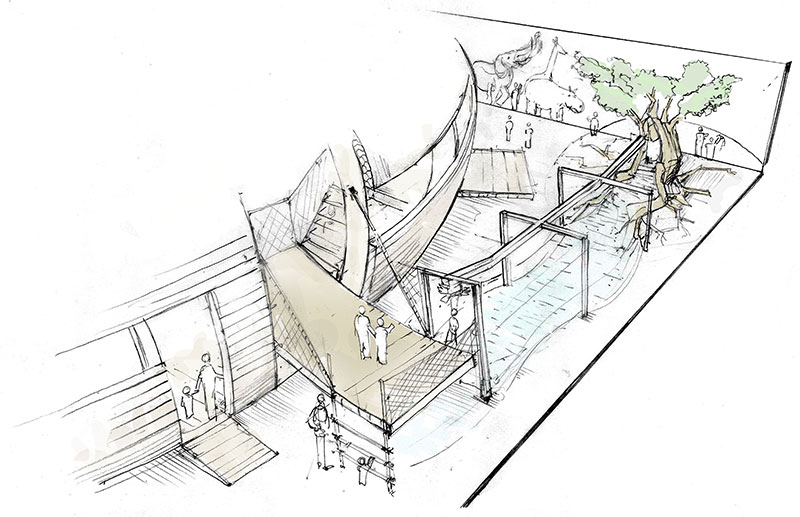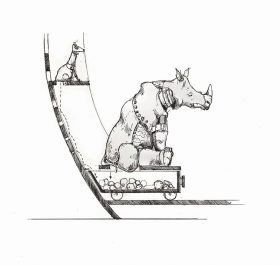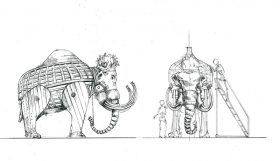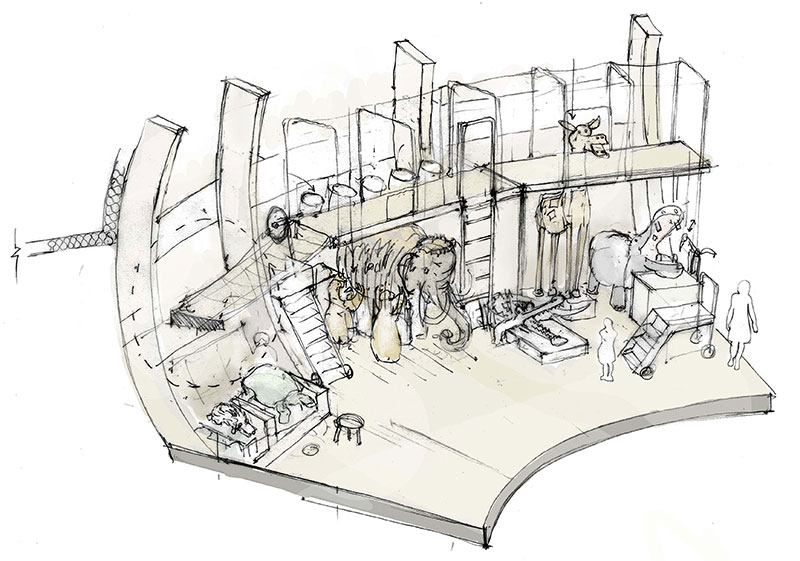A little story about a revolutionary kind of museum

In the W. Michael Blumenthal Academy construction is currently underway on a Noah’s Ark-themed children’s museum; Jewish Museum Berlin, Olson Kundig Architecture and Exhibit Design, Seattle/WA, USA
“Do not touch!”—These three words are irrevocably associated with traditional museums. They denote an institutional balancing act. On the one hand, the historical objects and works of art that are gathered in museums are supposed to be made accessible to the public. On the other hand, the objects must be protected from the damage that might be done by overenthusiastic visitors. Despite what museologist Fiona Candlin describes as “low-key unauthorized touch”—stroking statues when unobserved, secretly tracing hieroglyphics with an index finger—a visit to a museum remains a mostly visual experience.
While many museum institutions now make an effort to extend their offerings to the other senses, for decades children’s museums have practiced a hands-on approach. The classic form of an exhibition with an object that is framed or displayed in a vitrine accompanied by text prevents direct interaction with the object. Children ask questions, seek the answers themselves, and in the process they actively shape an exhibition.

The rhino loves action! And what about the dog? The two of them don’t want to spend their lives behind glass; Jewish Museum Berlin, Olson Kundig Architecture and Exhibit Design, Seattle/WA, USA
The hands-on approach was developed by Michael Spock at the Boston Children’s Museum. The exhibition What’s Inside, which opened in 1964, allowed children to use all of their senses to discover the inner workings of everyday objects such as toasters, balls, or rain drops, drawing young visitors to the museum from all across North America. The hands-on method quickly proved to be the preferred mode of museum work with children. In a 1991 speech at the ceremony of the “Great Friend to Kids Award”, Michael Spock emphasized that unlike traditional museums, at children’s museums it isn’t themes or objects that are the focus of attention, but rather the people one wishes to address: “What makes a children‘s museum different is that it is for somebody rather than about something.”
He also highlights another avant-garde principle that is realized in children’s museums, which a contemporary museum mission or vision can hardly avoid: orientation toward target audience and visitors. The insight that children need a special place for their curiosity is not so far from the idea that various social groups—and age groups—have different conditions for accessing culture and different interests in cultural characteristics.
The cornerstone for a museum that explicitly responds to the needs of very young visitors was laid in New York. The Brooklyn Children’s Museum, the world’s first, opened its doors in 1889. In particular, curator Anna Billings Gallup helped the museum concept to become a reality. She was of the opinion that children in a museum should never be seen as “troublemakers” and that “the keynote of childhood and youth is action”.
The enormous success of this credo led to further children’s museums being founded in the first third of the twentieth century in Boston, Detroit, Indianapolis, and West Hartford. The activities of the Boston Children’s Museum led to a real children’s museum boom in the 1960s. In the mean time, more than 200 museums for children exist in the country of their invention.

Scteches for the children’s museum; Jewish Museum Berlin, Olson Kundig Architecture and Exhibit Design, Seattle/WA, USA
In Germany, the 1968 generation first had to take culture and education down from their elite pedestal before children’s museums could enter the museum landscape as part of “New Cultural Politics” [“Neue Kulturpolitik“]. The founding of the Junior Museum in the Ethnological Museum of Berlin marked the beginning of this development, followed by the Young Museum Frankfurt, which celebrated its forty-fifth anniversary this year. Since the 1980s, a series of mobile children’s museums—including the Suitcase Museum in Nuremberg—have sought to reach children who wouldn’t otherwise go to museums. The first independent children’s museum with its own building was the Fulda Kinderakademie, founded in 1991.
The children’s museum of the Jewish Museum Berlin is set to open in fall 2019. At the moment, we’re refining a concept that will be a lot of fun for children aged three to ten. We’re inspired not only by the pioneers of the 130-year history of children’s museums, but also by the ZOOM Children’s Museum in Vienna, the FRida & freD children’s museum in Graz, and the JHM Children’s Museum in Amsterdam.

Most of the objects and animals at the children’s museum will be constructed out of recycled materials; Jewish Museum Berlin, Olson Kundig Architecture and Exhibit Design, Seattle/WA, USA
Despite all of these wonderful models, we still have questions that want to let our future visitors answer themselves. We’ll report more extensively here on Blogerim about the children’s advisory boards and workshops in schools, in which we’ve been talking with children about their idea of a great museum.
At this point we’d like to make clear that the history of children’s museums is in agreement with our young advisors regarding the three words mentioned at the beginning of this post: “Do not touch” plays no role in the Children’s Museum of the Jewish Museum Berlin.
This text is based on a speech by Anne Richter, research associate on the children’s museum project team, whose job it is, among other things, to envision a “better and different world” with children, guided by a philosopher of childhood.
Great Information.Thanks for Sharing.